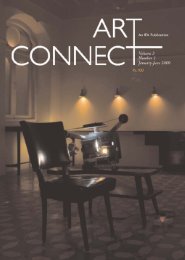Annual report 2003-2004 - India Foundation for the Arts
Annual report 2003-2004 - India Foundation for the Arts
Annual report 2003-2004 - India Foundation for the Arts
- No tags were found...
Create successful ePaper yourself
Turn your PDF publications into a flip-book with our unique Google optimized e-Paper software.
cannot be contained within a restricted timeframe and that partnerships between artists areoften most productive when <strong>the</strong>y are notfocused exclusively on tangible outcomes.Should IFA be extending assistance, <strong>for</strong> example,<strong>for</strong> ef<strong>for</strong>ts to set up a durable frame orplat<strong>for</strong>m <strong>for</strong> interactive arts practice? Shouldwe be supporting work that leads up to collaborativeactivity but is not necessarily its startingpoint? These are among <strong>the</strong> concerns that areprompting IFA to rethink <strong>the</strong> future of thisprogramme.<strong>Arts</strong> Education14While IFA is convinced that <strong>the</strong> artist’screative processes hold immense value <strong>for</strong> <strong>the</strong>field of education, we have found it difficult toidentify educational institutions capable ofdeveloping imaginative arts education projects.This is largely because <strong>the</strong> educational sectorviews <strong>the</strong> arts in exceptionally conventionalterms and envisions a very circumscribed role<strong>for</strong> <strong>the</strong> arts in education. Last year, <strong>the</strong>re<strong>for</strong>e,we began to shift our focus from trying tonegotiate grants with schools and colleges tothinking of ways of supporting artists and o<strong>the</strong>rprofessionals to work from <strong>the</strong> margins of <strong>the</strong>educational system. As a strategy, using <strong>the</strong> artsto enliven <strong>the</strong> extracurricular space might beeven more productive if it is in<strong>for</strong>med by alonger-term vision to bring <strong>the</strong> arts into <strong>the</strong>curriculum.IFA made three arts education grants in<strong>2003</strong>-04 that reflect this new thinking. The firstof <strong>the</strong>se grants is enabling <strong>the</strong> AttakkalariCentre <strong>for</strong> Movement <strong>Arts</strong> (ACMA) to developand implement an ‘Integrated MovementEducation’ programme in eight schools andtwo in<strong>for</strong>mal educational establishments inBangalore. With our support, ACMA is introducingstudents from diverse economic and socialbackgrounds to contemporary movement arts,training dancers to teach, and offering shortworkshops, apart from developing a danceeducation syllabus and curriculum <strong>for</strong> schools.ACMA’s initiative is significant because it signalsa per<strong>for</strong>ming art organisation’s altoge<strong>the</strong>r rarecommitment to developing and sustaining artspedagogy.This is a challenging assignment, not leastbecause ACMA has to attend to <strong>the</strong> task ofproducing trained dance teachers alongsideoffering a dance education programme inschools. To address this challenge, ACMAoffers a certificate course in ‘Movement <strong>Arts</strong>and Dance Education’, whose graduates <strong>the</strong>nserve as dance teachers in its ‘EducationOutreach Programme’. The dance teachers areencouraged to make <strong>the</strong>ir sessions with childrenvery interactive, and indeed to collaborate with<strong>the</strong>m in exploring creative approaches indance. They have also learnt to break down










